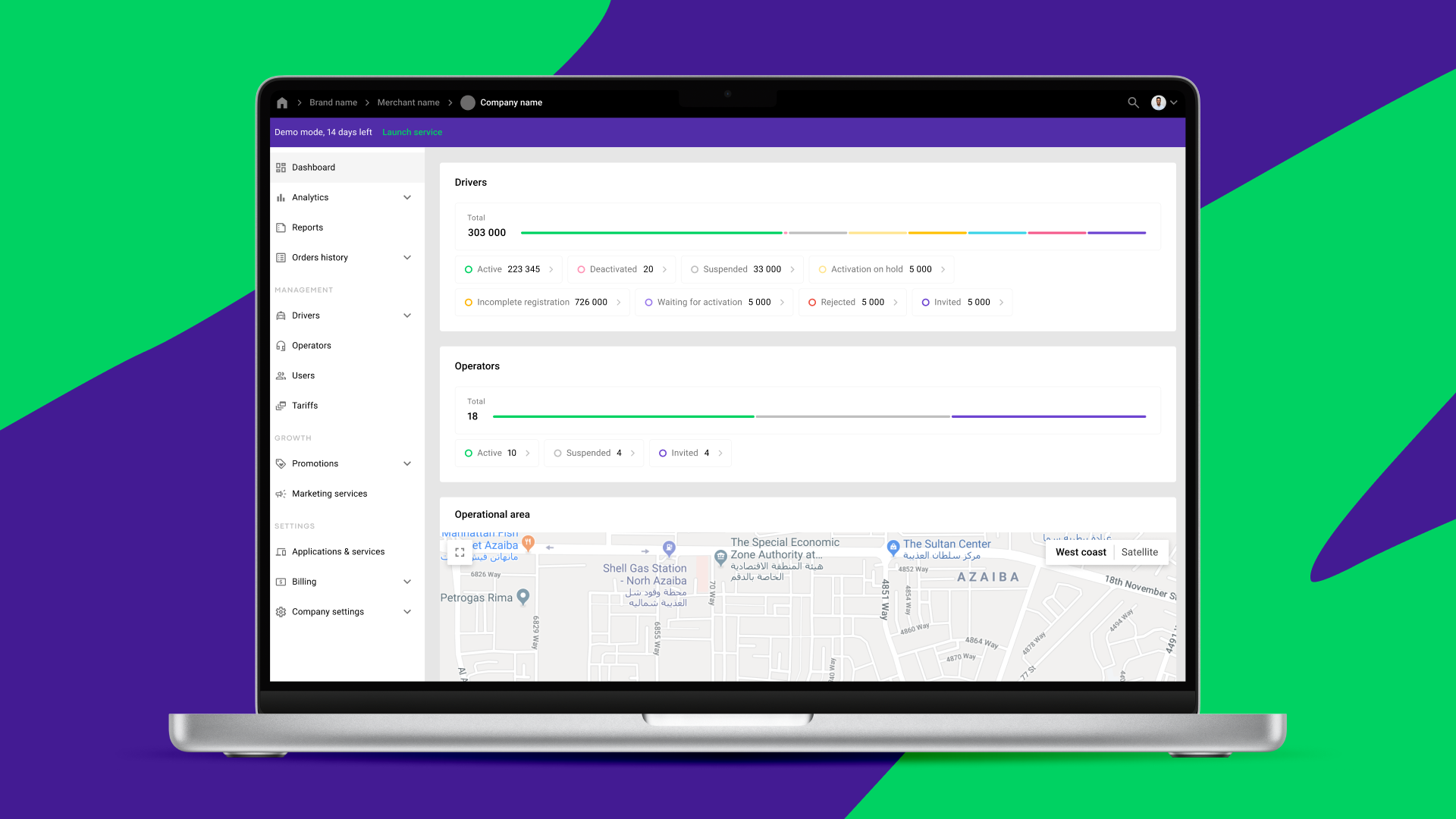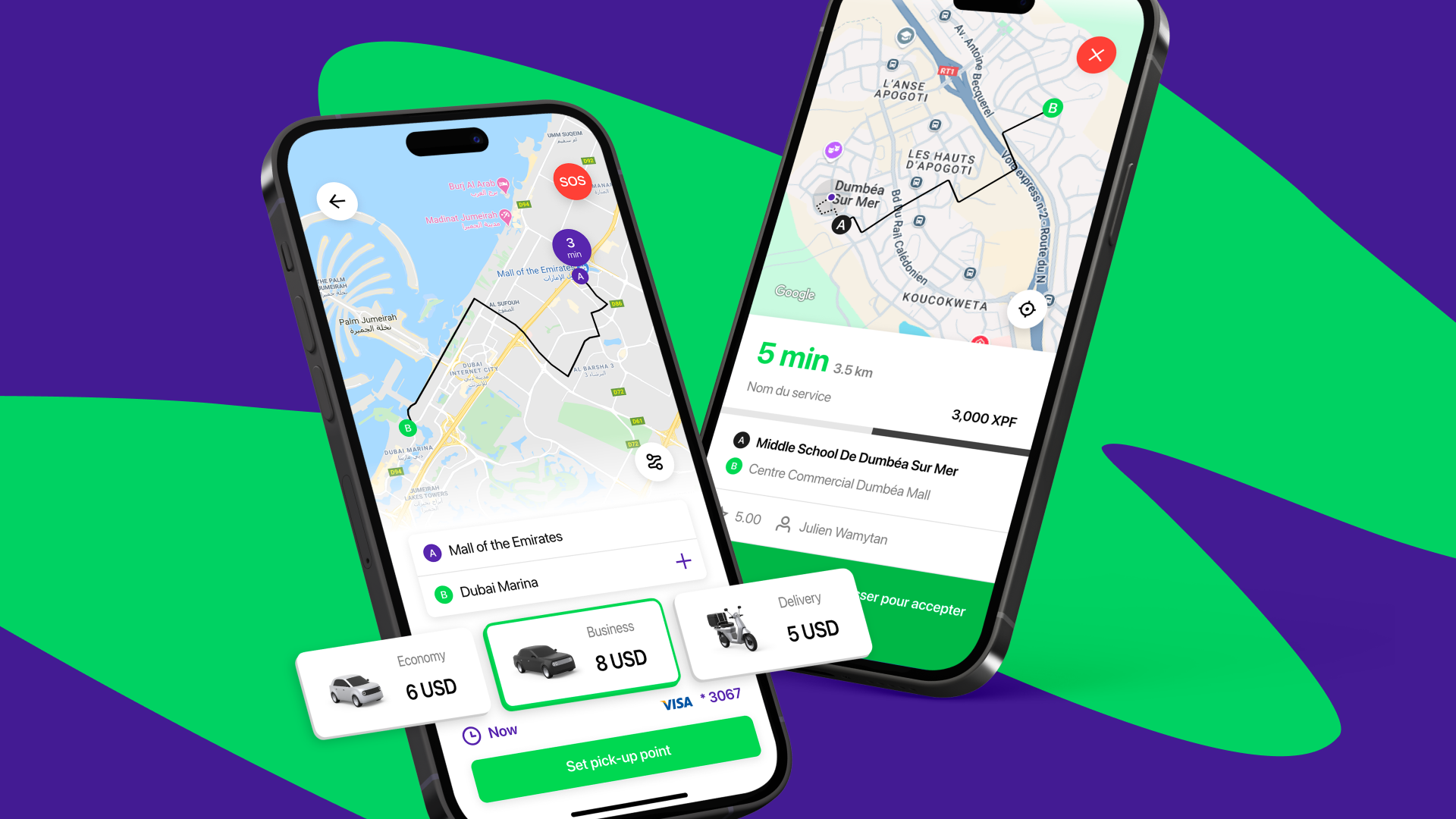Automate taxi business: how to leave WhatsApp & call centers behind
Every facet of the taxi business can now be served by highly specialized software:
- Automated dispatch systems
- Instantly collect and assign ride orders in real-time;
- Optimize routes and reduce wait times for customers;
- Improve operational transparency and resource allocation.
- Customer apps and Driver apps
- Enable passengers to easily book rides and drivers to accept them;
- Provide real-time GPS tracking and estimated arrival times;
- Offer multiple payment method.
- Admin panels
- Allow managers to create driver plans and set pricing for rides and zones;
- Allow full control of operations, including the flow of money and drivers’ idle time;
- Offer discount programs to attract customers and drivers;
- Support decision-making with business data: customer and driver statistics, peak demand prediction, heatmaps, ride reports, etc.
Choosing automation leads to better customer service, making transparency and efficiency the expectation. In the end, these streamlined, scalable, and highly responsive systems benefit everyone, from operators and drivers to passengers.
Industry leaders Uber and Lyft have built their entire model around automation. Before “Uberization,” taxi services relied heavily on phone bookings and cash payments. Uber and Lyft disrupted the industry by showing how convenient an automated system could be for everyone. They redefined customer expectations forever, forcing other operators to catch up.
After the Uber revolution, taxi and mobility companies can follow several strategic paths:
- The Local Challenger. Many local operators compete with global mobility leaders by offering better service, lower prices, or focusing on underserved regions.
- The Niche Specialist. Platforms like Wingz focus on specific segments in mobility, such as non-emergency medical transportation (NEMT). Services like this can thrive by tailoring their experience to a defined user group.
- The Super App. Companies like Grab in Southeast Asia have gone beyond ride-hailing, bundling mobility, food delivery, payments, and more into a single platform.
However, plenty of taxi operators are still handling bookings manually, via WhatsApp, call centers, or driver group chats. This old-school approach requires more manual labor, is prone to human error, and can lead to a poor experience in the era when customers are used to instant convenience.
Why, then, do WhatsApp and call centres remain popular?
Why do taxi businesses still use WhatsApp and call centres?
WhatsApp Business, which is now used by over 764 million people monthly, is popular in the transportation industry for its familiarity among customers and easy setup. In regions where WhatsApp dominates, like India, Brazil, Africa, and the Middle East, many operators use it as a simple dispatch and communication tool.
Traditional taxi companies often outsource order-taking and dispatch to call centers to extend availability, help drivers stay focused on the road, and avoid the overhead of hiring additional in-house staff. Beyond handling on-demand ride requests, call centers remain a go-to for managing pre-booked rides like airport transfers.

Moreover, it’s important to acknowledge that for many customers, speaking directly with a person, whether to place an order or resolve a dispute, builds trust and creates a more satisfying experience.
In short, both WhatsApp and call centers offer a low-cost, low-barrier entry into the taxi business. They are effective options for providers looking to test out a new business model and gauge customer demand before committing to something more complex and costly.
How do WhatsApp and call centers hold taxi businesses back?
While many customers still appreciate the human touch, expectations are shifting. More and more people get used to the speed and convenience of app-based services and come to expect it whenever they travel. On the business side, rising demand for rides and increasing competition for both customers and drivers are putting new pressure on taxi companies that, until recently, were doing just fine.
That’s where tools like WhatsApp Business and call centers fall short.
WhatsApp may be familiar and easy to use, but it lacks essential features like payment integration, structured order tracking, and fleet management. Call centers, meanwhile, rely heavily on manual work, which slows things down, increases the chance of human error, and makes scaling expensive.
By not adopting automated tools, many taxi businesses are missing out on significantly increasing their order volume, improving customer loyalty, and saving thousands in operational expenses. A modern ride-hailing platform not only streamlines operations but also unlocks new levels of growth that simply aren’t possible with old-school methods.
Let’s see how WhatsApp and call centers compare to modern automation solutions like Onde.
WhatsApp vs call centers vs Onde in taxi business management
Category | Call Center | Onde Platform | |
|---|---|---|---|
| Ease of Setup | simple | simple | guided setup with expert support |
| Cost to Run | very low | operator wages + call costs | flexible pricing (setup + monthly fee) |
| Scalability | limited scalability, requires hiring more managers as | limited scalability, requires hiring more operators as the business grows | unlimited scalability |
| Fleet Management | none | none | full control over vehicles, drivers, and zones |
| Booking Management | messy, unstructured | prone to delays | automated dispatch and app bookings |
| Driver Coordination | no fair order distribution | manual & error-prone | intelligent order distribution algorithm |
| Data & Analytics | no insights or reporting | no insights or reporting | performance data and monthly reports |
| Branding | no branding | limited branding | your logo and brand colors |
| Privacy & Security | data stored by Meta | data stored by your business | data stored by your business |
| Order Handling Capacity | limited by chat speed | limited by operator response time | unlimited, handles thousands of orders automatically |
How to know it’s time to automate your taxi service?
If you’re still juggling bookings through WhatsApp or relying on call centers, chances are you’ve already felt the limits of that system. Here are some clear signs that an upgrade is in order:
- You want to attract and keep more customers.
- You’re struggling to manage your drivers.
- You need better visibility into your cash flow.
- You want to scale your operations.
- You want to provide more payment flexibility.
- You want to make smarter decisions with data.
- You want to improve the customer experience.
- You want more control over your infrastructure.
- You’d like to spend less time on admin and focus on what matters.
If even a few of these sound familiar, it’s a good idea to start looking into your automation options.
How do you automate a taxi service without issues?
For a first-timer, automating a business can feel daunting. Picking the right solution for your business is a challenge on its own, and then comes the transition. It’s better to make the switch with a partner who knows the road ahead and has your best interests in mind.
At Onde, we make the process simple by offering a SaaS ride-hailing platform with a full set of white-label apps covering every need of a modern taxi business.
Switch to Onde in 5 easy steps
Switching to Onde is easy, safe, and requires no tech skills from your side.
Step 1: Sign up for a personalized demo
Try Onde for yourself and see how it fits your business goals and technical needs.
Step 2: Plan the transition
We’ll work with you to create a migration plan based on your current setup.
Step 3: Import your data
Our team will transfer your driver info to the new system and send automatic invites to your drivers.

Step 4: Launch your new apps
We’ll publish your branded apps on the App Store and Google Play.
Step 5: Go live
We’ll smoothly redirect customers to your new app or replace the old one entirely.
Wondering how long it takes? Most transitions take just 2 to 4 weeks. Let’s talk it through and find the best path for your business — book a call with us today.
